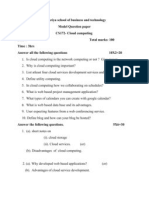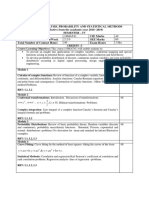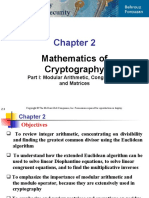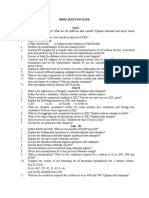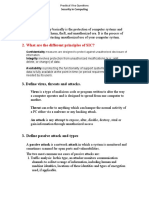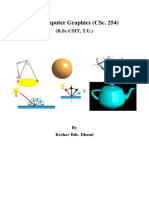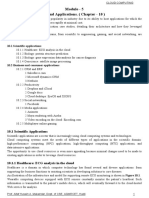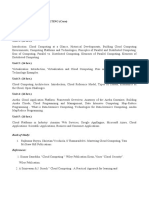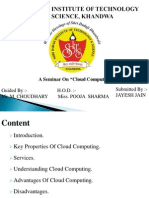0%(1)0% found this document useful (1 vote) 2K views5 pagesCloud Computing PDF
Copyright
© © All Rights Reserved
We take content rights seriously. If you suspect this is your content,
claim it here.
Available Formats
Download as PDF or read online on Scribd
CLOUD
COMPUTING
Shailendra Singh
Professor
Department of Computer Science and Engineering
National Institute of Technical Teachers
Training & Research, Bhopal
OXFORD
UNIVERSITY PRESS
Scanned with CamScanner�26 | Cloud Computing
[EAppticatons
a
Database
Router |
Host3 Host Cloud services
Enterprise provided by
(Working with cloud provider
cloud data)
Fig. 1.9 Enterprise cloud computing
@ Points to Remember eo
1. Cloud computing is a technology which uses the Internet and central remote servers (data center) to
maintain data, software, storage, and applications. It offers the following:
(a) On-demand self-sufficient services
(b) Omnipresent network access
(©) Location-independent resource (access from anywhere)
(d) Speedy elasticity
Cloud application doesn’t need software or a server to use it and does not call for software updation.
Cloud computing allows users to use any application without installation and access their files at any
computer with Internet access any time.
Cloud computing is becoming a progressively more attractive alternative for many organi:
Cloud computing promises to reduce operational and capital costs.
Peer-to-peer is a decentralized approach having no center serv
Cloud computing is essential as it helps in reducing costs; offers scalability, remote access, disaster
relief, ease of implementation, and better response time; and provides a virtual environment.
8, Grid is the application of multiple computers working on a single problem at the same time,
9. In utility computing, computing resources are disbursed as per usage.
10. Software as a Service is beneficial in usage based payments to applications.
11, Virtualization means the logical partitioning of physical computing resources into multiple execution
environments, including servers, applications, and operating systems.
12. Building the cloud infrastructure involves the following:
(a) Understanding the existing traditional data center
(b) Virtualizing the computing resources
(©) Deploying service management tools
13. Cloud computing has the ability to increase the usage level of the infrastructure through multi-tenaney.
14, Windows Azure is a Microsoft Cloud computing platform used to build, deploy, and manage applications
through a global network of Microsoft-managed data centers.
15. Major challenges with traditional infrastructure software licensing and support, scalability, ac
ity, modifiability, physical security, and cost management.
16. The limitations of cloud computing are availability of service, data lock-in, data segregation, privilege
neglect, scaling resources, data location, deletion of data, recovery and backup, offline cloud, and
unpredictable performance.
ions.
Rae
untabi
Oxford University Press. All rights reserved.
Scanned with CamScanner�28 | Cloud Compuing
Utility computing The packaging and delivery of computing resources toa customer who pays for the resources,
asa metered-based service when needed. Customers have to pay on the basis of how much they have used.
Web workers A novel method to take on gear jobs which should hold up the web browser
Which of the following is an example of a
cloud computing application?
(a) Facebook
(b) Twitter
(©) Skype
(d) Salesforce.com and Googleapp
(©) All the above
Multip!
The logical partitioning of physical computing
resources into multiple execution environ-
ments is called:
(a) Grid computing,
(b) Platform virtualization
(©) Distributed computing
(@) None of these
‘The term used to describe a hypervisor running
multiple operating systems simultaneously is:
(a) Full virtualization
(b) Para virtualization
(©) Partial virtualization
(a) Nested virtualization
Which among these best describes the differ-
ence between SOA and cloud computing?
(a) Metered service
(b) Shared resources
(©) SOA existing within a firewall
(@) Leveraging IT resource on demand
Cloud is a set of that
provide the service.
(a) Hardware
(b) Networks
(c) Storage and services interfaces
(@) All the above
‘The participants in cloud computing are
(@) The end user
(b) The business management which has the
responsibility of managing the overall
cloud governance and provide services to
the customer
‘choice Questions
10.
u
(©) The cloud service provider who are
responsible for IT assets and maintenance
(d) All the above
The core elements of a traditional data center
isfare
(a) DBMS
(b) Compute
(©) Network
(@) Allithe above
Peer-to-peer isa
(a) Decentralized approach
(b) Centralized approach
(€) Distributed approach
(4) None of these
‘The advantages of client server networks is!
are.
(a) Centralization
(b) Proper management
(©) Backup and recovery possible
(d) All the above
The objective of autonomic computing is to
have the computer perform
(a) Critical and complex functions
(b) Virtualization
(©) On-demand services
(@) None of these
Security is enhanced by which services in the
cloud infrastructure?
(a) Intrusion prevention
(b) Hardware (intelligent switch)
(©) Isolation of virtual network
(d) File providing different permissions
(©) DHCP used to track the IP address
What is cloud computing replacing?
(a) Expenses of computer hardware
(b) Software upgrades expenses
(©) Data centers
(@) All the above
Oxford University Press. All rights reserved.
Scanned with CamScanner�Overview of Cloud Computing | 29
13. What is the prime concem about cloud comput- (a) Employee satisfaction
ing? (b) Cost reduction
(a) Security concerns (©) Sensitivity of information
(b) Too many platforms (@) All the above
(c) Accessibility 18. The challenges with traditional infrastructure
(@) Too expensive ifalade:
14, Which of these is not the leader of cloud comp- (a) Software licensing and support
uting? (b) Scalability
(a) Google (©) Accountability and modifiability
(b) Amazon (@) All the above
(6) Blackboard 19. ‘The advantage of cloud over remote hosting i
(@) Microsoft
15. Which of the following is not a major cloud (a) Virtual servers or physical servers that can
computing platform? be customized to different plans through a
(a) Google 101 control pane!
(b) IBM Deep blue (b) Dedicated IP addresses for cloud servers
©): Microsott (c) Replication or distribution over various
(@) Azure distant locations
16. What represents the ‘cloud’ in cloud comput- (@) All the above
ing? -
(a) Wireless 20. Which of these are the challenges of cloud
(b) Wireless LAN computing
(c) Crowd of people (a) Safeguarding data security
(@) The Internet (b) Managing the contractual relationship
(©) Managing the cloud
17, Whichof these shoulda company consider before
(d) All the above
implementing cloud computing technology?
@ Review Questions eo
. What is cloud computing and how is it different from the Internet?
.. What is the need of cloud computing”?
. Explain the different elements responsible for the origination of cloud computing.
. What are the core elements of a traditional data center?
What is virtualization? What are its various benefits?
. What is distributed computing? Explain.
What is grid computing? How is it different from cloud computing?
. How is a traditional data center different from a cloud data center?
What are the various services provided by cloud computing?
10, What are the advantages of peer-to-peer networking?
11, What are the various challenges of cloud computing?
12. How is cloud computing beneficial”
13, How can you say that security is one of the major challenges for cloud use
14, Why is data segregation a limitation for cloud users?
15, What do you understand by remote access?
16. How can you say that interoperability and portability are the challenges of cloud computing?
17, What are the various vendors of cloud computing?
18, How can we use Windows Azure in the application platform of a public cloud?
eeraneype
Oxford University Press. All rights reserved.
Scanned with CamScanner�19,
20.
2.
). Cloud Computing and Virtualization, V. Rajeswara Rao, V. ShubbaRamaiah, ISBN-10: 9383
. National Institute of Standards and Technologies (NIST) hutp://es
Cloud Computing
‘What do you understand by customization? How can we use it in cloud computing?
‘What are the applications of utility computing with reference to cloud computing?
‘What is the need of elastic computing?
e References e
Cloud Security A Comprehensive Guide to Secure Cloud Computing, Ronald L. Krutz and Russell
Dean Vines, ISBN: 978-0-470-58987-8, Wiley Publication, 2010
Cloud Computing for Dummies, Judith Hurwitz, Robin Bloor, Marcia Kaufman, and Dr Fern Halper,
ISBN-10: 0470484705, Wiley Publication, Ist edition, November 16, 2009
Cloud Computing Technologies and Strategies, Brian J.S. Chee and Curtis Franklin, Jr, ISBN
9781439806128, CRC Press, April 16, 2010
Cloud Computing: A Practical Approach, Anthony T. Velte, Toby J. Velte, Ph.D., Robert Elsenpeter,
ISBN-10: 0071626948, McGraw-Hill, Ist edition, November 1, 2009
Grid and Cloud Computing, Katarina StanoevskaSlabeva, Thomas Wozniak, and Santi Ristol, ISBN-
10; 3642051928, Springer, 2010 edition, November 19, 2009
. Implementing and Developing Cloud Applications, David E.Y.Sarna, ISBN-10: 1439830827,
Auerbach Publications, November 26, 2010
. Market-oriented Cloud computing: Vision, Hype, and Reality for Delivering It Services as Computing
Utilities. In High Performance Computing and Communications, R. Buyya, C.S. Yeo, and
S. Venugopal., 2008. HPCC’08, 10" IEEE International Conference, pp. 4-13 IEEE, 2008
Mastering Cloud Computing, Rajkumar Buyya, Christian Vecchhiola, S. Thamarai Selvi, Tata
‘McGraw Hill Education Private Limited, 2008,
5045,
BS Publications/BSP Books, 2014
nist. gov/publications/
nistpubs/800- 145/SP800-145.pdf, last accessed in January 2015
Answers to Multip!
choice Questions
Le© 5. @) 9. @) 13. (@) 17. @)
2. (o) 6 @) 10. (a) 14. (©) 18. @)
3. @) 7 @ 11. (a)and (©) 15. (b) 19. @)
4@) 8 @) 12 @ 16. d) 20. @)
Oxford University Press. All rights reserved.
Scanned with CamScanner


















